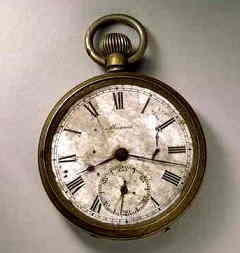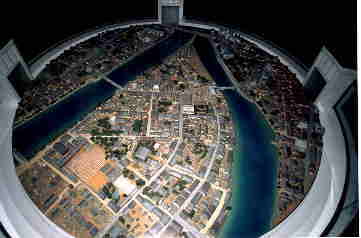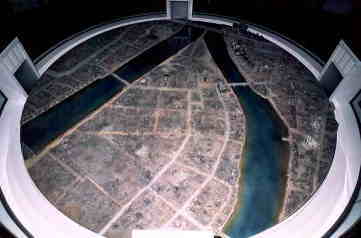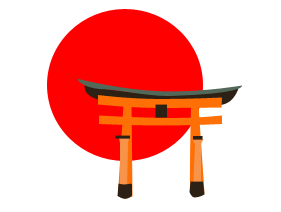| ++The Manhattan Project++ |
In August 1942, the United States launched the Manhattan Project to produce an atomic bomb. In September 1944, the decision was made to use the new weapon against Japan. On July 16, 1945, the United States successfully carried out the world’s first nuclear weapon test in the desert of New Mexico, a mere three weeks before the weapon was dropped on Hiroshima. By May 1945, Germany had surrendered and the tide of the war had turned overwhelmingly in the favor of the Allied Forces. |
| ++Hurried use++ |
| Three factors probably led to the hurried dropping of the A-bombs:The United States wanted to limit its own casualties by forcing Japan to surrender as quickly as possible. At the Yalta-Conference in February 1945 the Soviet Union secretly agreed to join the war against Japan within three months of Germany’s surrender. The United States wanted to force Japan to surrender before the Soviet Union could enter the war to secure a stronger political position after the war. The U.S. wanted to use the weapon in war to measure its effectiveness. |
| ++Reasons for Selecting Hiroshima++ |
By the end of the war, most of Japan’s major cities had been destroyed by U.S. air attacks. Hiroshima was still intact. The reasons Hiroshima was chosen as the target for the A-bombing are assumed to be the following.The size and the shape of the city was suited to the destructive power of the A-bombs. Because Hiroshima had not been bombed, ascertaining the effects of the A-bomb would be relatively easy. Hiroshima had a high concentration of troops, military facilities and military factories that had not yet been subject to significant damage. |
| ++Targets for the A-bombing++ |
| ++The American decision-making process 1945++ |
| April…The following regions were selected for study as potential targets: Tokyo Bay, Kawasaki, Yokohama, Nagoya, Osaka, Kobe, Kyoto, Hiroshima, Kure, Yahata, Kokura, Shimonoseki, Yamaguchi, Kumamoto, Fukuoka, Nagasaki, Sasebo. May…A-bomb targets were narrowed to Kyoto, Hiroshima and Niigata. June…Kyoto was scratched from the list. Targets were Kokura, Hiroshima and Niigata. July(25th) Order to drop on Hiroshima, Kokura, Niigata, Nagasaki. (31st) Hiroshima was chosen as a priority target. August (1st) Niigata was scratched from the list. (3rd) Final order set the day of attack as August 6 — Hiroshima, Kokura and Nagasaki were targets. (6th) A-bombing on Hiroshima. (9th) A-bombing on Nagasaki. |
++Watch stopped at 8:15++

The time of 8:15 a.m., August 6th, 1945 is an eternally memorable moment for the world as well as for Hiroshima.
++Panorama before and after the bombing++

++Before the Bombing++
>>The night before the A-bombing (August 5)
From the evening of August 5, 1945, to the early morning of August 6, sirens and air-raid warnings were sounded frequently. City residents passed a fitful night. On the morning of August 6, the alarms finally stopped, the all-clear siren sounded, and that morning began like any other, with people hurrying to work and with those mobilized for demolition work heading to their assigned sites.
>>Hiroshima City
The area sandwiched between the Honkawa and Motoyasu Rivers was the downtown shopping and entertainment district since the end of the Shogunate government (1867), through the Meiji period and into the Taisho era, which ended in 1925. Large shops lined along a shopping arcade in Nakjima-Honmachi. Tenjin-machi, Motoyanagi-machi and Nakajima-Shinmachi were also a shopping area. Zaimoku-cho and Kobiki-cho were a lumber trading area. Many old temples and shrines of historical value also stood.
Because of the threat of air-raids, however, much of Tenjin-machi, Kobiki-cho, and Nakajima-Shinmachi was demolished for fire lanes. Some pupils at the Nakajima and Honkawa national schools were evacuated to rural areas.
>>Air raid
In early 1945, the American military began indiscriminate incendiary bombing at night, flying in huge formations, repeatedly attacking numerous targets throughout Japan, including medium and even small cities.
Hiroshima had thus far escaped this kind of air attack, but to halt the spread of fires and create open areas for refuge in the case of large-scale air attacks, wooden houses were demolished, and air-raid shelters were built for individual homes and for each neighborhood association. Fire-prevention and evacuation drills took place regularly.

++After the bombing++
>>The atomic bombing (August 6).
8:15 A.M., August 6, 1945, Hiroshima was a picturesque, quiet city. Then with a blinding flash and a deafening roar, a single bomb burned into to the ground. An entire city was instantly destroyed beyond recognition.
Nearly all people and buildings within a two-kilometer radius of the hypocenter were killed or destroyed. By the end of the year approximately 140,000 were dead or missing, nearly half of the almost 350,000 residents.
>>Cremating bodies.
Tremendous numbers of unidentified corpses were piled up and cremated on the spot. The injured and irradiated continued to die. Day and night in every corner of the city, corpses are piled upon the corpses and burned.
>>Scorched plain
Hiroshima was a charred plain as far as the survivors eyes could see. Survivors claim they could stand Hiroshima statue and see Ujina port. Those who entered the city out of concern for relatives or help with relief efforts were exposed to residual radiation. To add to the misery,the city was flooded by rain that fell from the massive Makurazaki Typhoon.


